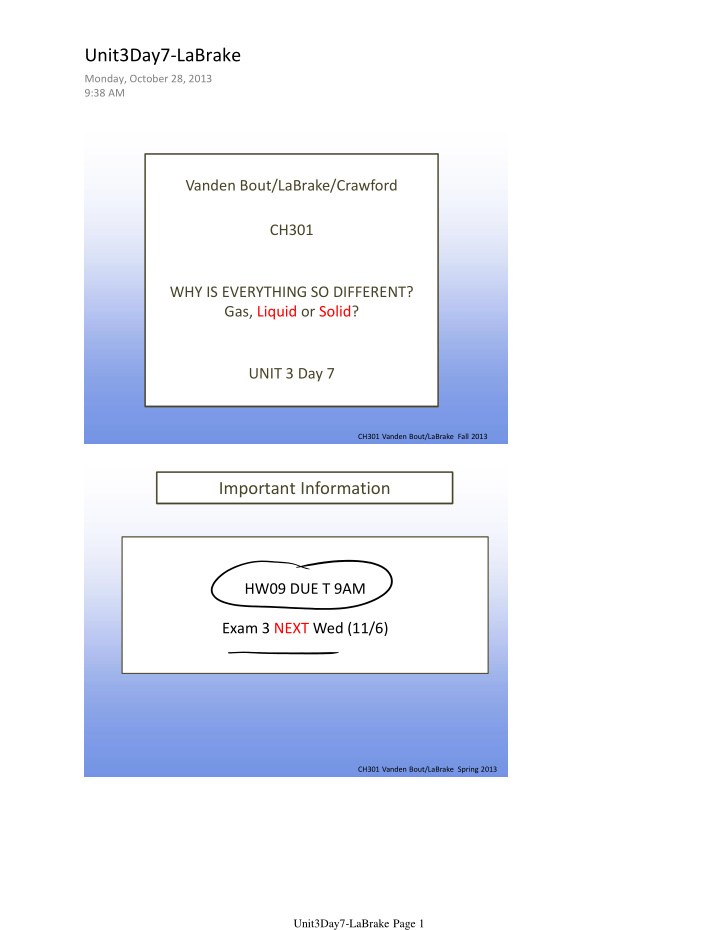



Unit3Day7-LaBrake Monday, October 28, 2013 9:38 AM Vanden Bout/LaBrake/Crawford CH301 WHY IS EVERYTHING SO DIFFERENT? Gas, Liquid or Solid? UNIT 3 Day 7 CH301 Vanden Bout/LaBrake Fall 2013 Important Information HW09 DUE T 9AM Exam 3 NEXT Wed (11/6) CH301 Vanden Bout/LaBrake Spring 2013 Unit3Day7-LaBrake Page 1
What are we going to learn today? Properties of Liquids – Think Some More Properties of Solids – Different Types CH301 Vanden Bout/LaBrake Fall 2013 QUIZ: iClicker Question 1 Viscosity is… a) Thickness b) Density c) Ability to flow d) Resistance to flow CH301 Vanden Bout/LaBrake Fall 2013 Unit3Day7-LaBrake Page 2
Poll: iClicker Question 2 Studying chemistry with other students outside of class is helping me learn the material. A) I only study alone. B) My group is very helpful. C) My group is helpful. D) My group is only a little helpful. E) My group is not helpful at all. CH301 Vanden Bout/LaBrake Spring 2013 Study Groups are Effective When 2 or more students work collaboratively to solve the problem or engage in constructive dialogue, they • Outperform those learning individually. • Are exposed to different perspectives. • Are required to negotiate to achieve understanding. • Retain their knowledge longer. (Ding & Harskamp, 2011) CH301 Vanden Bout/LaBrake Spring 2013 Unit3Day7-LaBrake Page 3
Vapor Pressure We’ve extensively discussed the relationship between boiling point and IMF. What is the relationship between boiling point and vapor pressure? CH301 Vanden Bout/LaBrake Fall 2013 Poll: iClicker Question 3 Which of the following has the highest vapor pressure? a) CH 3 OH b) CH 3 CH 2 OH c) CH 3 CH 2 CH 2 OH d) CH 3 CH 2 CH 2 CH 2 OH CH301 Vanden Bout/LaBrake Fall 2013 Unit3Day7-LaBrake Page 4
Evaporation Boltzmann distribution explains evaporation CH301 Vanden Bout/LaBrake Fall 2013 Poll: iClicker Question 4 Which distribution is at higher T? A B C CH301 Vanden Bout/LaBrake Fall 2013 Unit3Day7-LaBrake Page 5
-100 20 600 CH301 Vanden Bout/LaBrake Fall 2013 Poll: iClicker Question 5 What do you think will happen to the viscosity as the temperature is increased? A)It will go up B)It will go down C)It will stay the same CH302 Vanden Bout/LaBrake Fall 2012 Unit3Day7-LaBrake Page 6
Physical Properties Properties of Liquids based on intermolecular forces and shapes of molecules Properties of Solids based on intermolecular forces and the type of bonding CH301 Vanden Bout/LaBrake Fall 2013 Poll: iClicker Question 6 Diamonds are a) A bunch of C atoms held together by dispersion forces b) A bunch of C molecules held together by dipole dipole interactions c) A bunch of C atoms covalently bound together d) A bunch of C molecules held together by dispersion forces CH302 Vanden Bout/LaBrake Fall 2012 Poll: iClicker Question 7 Graphite is a) A bunch of C atoms held together by dispersion forces b) A bunch of C molecules held together by dipole dipole interactions c) A bunch of C atoms covalently bound together Unit3Day7-LaBrake Page 7 d) A bunch of C molecules held together by dispersion
Poll: iClicker Question 7 Graphite is a) A bunch of C atoms held together by dispersion forces b) A bunch of C molecules held together by dipole dipole interactions c) A bunch of C atoms covalently bound together d) A bunch of C molecules held together by dispersion forces CH302 Vanden Bout/LaBrake Fall 2012 Poll: iClicker Question 8 Solids are classified into four different categories Ionic Covalent Metallic Molecular We’ve already discussed two types of solids this semester. Which ones have we discussed? A. Ionic and Covalent B. Metallic and Covalent C. Molecular and Ionic D. Metallic and Molecular CH301 Vanden Bout/LaBrake Fall 2013 Unit3Day7-LaBrake Page 8
Types of Solids Covalent or (Network) Ionic Metallic Molecular Types of Solids Class Examples Characteristics Ionic NaCl, KNO 3, Hard, rigid, brittle; high CuSO 4 •H 2 O melting/boiling points; those soluble in water give conducting solutions Network B, C, black P, BN, Hard, rigid, brittle; very high melting SiO 2 points; insoluble in water Metallic s- and d - elements Malleable, ductile, lustrous; electrically and thermally conducting Molecular BeCl 2 , S 8 , P 4 , I 2 , ice, Relatively low melting/boiling points; glucose brittle if pure CH301 Vanden Bout/LaBrake Fall 2013 Unit3Day7-LaBrake Page 9
Physical Properties of Solids Class Electrons Conductivity Ionic Localized Not a good conductor (only conducts electricity in aqueous solutions) Network Localized Not a good conductor Metallic Delocalized Good conductor Molecular Localized Not a good conductor CH301 Vanden Bout/LaBrake Fall 2013 Physical Properties of Solids Ionic Metallic Unit3Day7-LaBrake Page 10
Physical Properties of Solids Molecular Network CH301 Vanden Bout/LaBrake Fall 2013 Predicting Melting Point Trends We can use melting points to distinguish between covalent and molecular solids Molecule Melting Point [K] Type of Solid Diamond 3823 SiO 2 1900 Gold 1337 NaCl 1074 Sugar 423 Naphthalene 353 Ice 273 CO 2 190 CH301 Vanden Bout/LaBrake Fall 2013 Activity Recall Unit 3-Activity 1 (pg. 75) After discussing IMFs, shapes of liquids, and types of solids, can you now draw better pictures? Please complete the new Activity Unit3Day7-LaBrake Page 11 IMF Unit- Constructing a Microscopic and Macroscopic
Activity Recall Unit 3-Activity 1 (pg. 75) After discussing IMFs, shapes of liquids, and types of solids, can you now draw better pictures? Please complete the new Activity IMF Unit- Constructing a Microscopic and Macroscopic View of Substances (ph. 81) CH301 Vanden Bout/LaBrake Fall 2013 Unit3Day7-LaBrake Page 12
What have we learned today? Condensed phases exist because of IMFs Electrostatic Forces vary with shape, size, components of the compound, allowing for various phase transition temperatures Properties of liquids and solids depend on IMFs CH301 Vanden Bout/LaBrake Fall 2013 Learning Outcomes Recognize the four types of solids: ionic, covalent (network), metallic, and molecular Recognize how the macroscopic properties of solids (melting point, hardness, conductivity, etc.) can be explained by the microscopic model of solids CH301 Vanden Bout/LaBrake Fall 2013 Unit3Day7-LaBrake Page 13
Recommend
More recommend